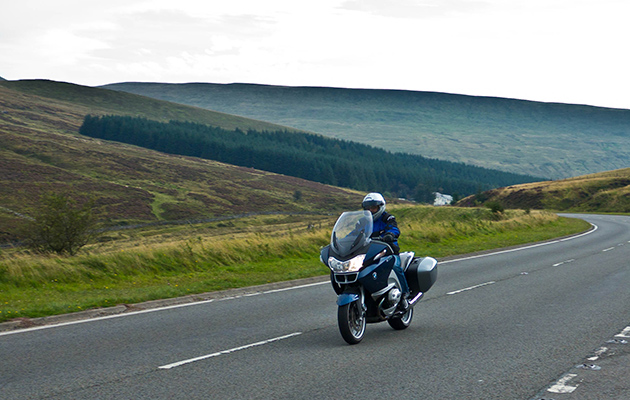Her father had wanted to encourage her to push her boundaries and experience the world, and not let her vision impairment slow her down.
Ms O’Connor has a rare condition called achromatopsia, which causes colour blindness and sensitivity to light and glare.
“So, choice and control really.”
As a child, Ms O’Connor took up horse riding, and, when she entered the workforce, she began commuting on an electric bicycle, using red-tinted sunglasses to help cut the glare.
But when she discovered bioptic driving was permitted in Australia, she became “obsessed and determined” to become a candidate.
She earned her driver’s licence in 2016 and soon after set her sights on the “logical next step” — achieving her dream of riding a motorcycle.
“I did some investigating and surprisingly I found quite a lot of other bioptic motorcyclists in the United States,” she said.
“I sent emails and asked questions about how they adapted the bioptic to fit their helmet, and how they adapted their motorcycle and what kinds of techniques they used to teach themselves, and integrated that into my learning.”
Her years of research and planning paid off, and in 2020, Ms O’Connor became Australia’s first licensed bioptic motorcyclist.
In order to ride a motorcycle, Ms O’Connor uses a device called a bioptic telescope, which helps to colour-correct and improve long-distance vision.
In addition to the bioptic, she wears red-tinted glasses.
“That lets me see things like the red brake lights, the indicator lights, the red and orange traffic lights,” Ms O’Connor said.
“Then, for me to be able to see the green lights, I dip and look through my scope to see that the green is on.
She also had to make modifications to her motorcycle because she couldn’t clearly see the speedometer.
“I can see the dial moving but I can’t see where it is actually landing,” she said.
“So, I have high contrast little bullets at the various stages of 40, 60, 80, 100 and that gives me an indication to see where the indicator lies so I know what speed I’m at.”
To improve her skills on the road, Ms O’Connor also had private riding lessons with instructor Steve Lake.
“I actually didn’t really need to apply any different strategies,” Mr Lake said.
“I very quickly realised that she could see all the cones, she could see the edges of the training area.
“I was helping Belinda learn to control the motorcycle and do activities like cone weaves, U-turns, swerving and emergency stopping.”
While Ms O’Connor has overcome many hurdles to become a motorcyclist, she says one challenge persists — the prejudice of others who perceive vision-impaired riders as a risk on the road.
“People question, ‘what if you fall off and have an accident and break your bioptic, you can’t drive?’,” she recalled.
“But it’d be pretty much the same for anyone who has to wear glasses anyway, because they can’t ride without glasses if they’re broken.”
Another comment she received was, “I don’t want a vision-impaired person on the road. What if they smash into my car and fall through my windscreen?” she said.
“And I’m like, well that’s just a really, really silly thing to say, because why would I be in that position in the first place?
Mr Lake said he had “complete faith in Belinda to be a safe rider on the road”.
He said the real issue when it came to road safety was behaviour, with even very skilled riders able to make unwise decisions that could lead to accidents, particularly when tired or rushed.
“To be a safer rider or driver, it’s about risk management,” he said.
“I’ve found anybody with any kind of condition [or disability], they’re actually very good at risk management, because naturally they understand that their condition makes it a little more difficult.
“They tend to drive or ride locally, and they’re very careful about what they do. So, I consider they’re quite safe.”
Ms O’Connor has since become a pioneer for other vision-impaired drivers in Australia, with another driver passing their bioptic motorcycle test recently in South Australia.
And while not everyone with central vision loss will be a candidate for bioptic riding, Ms O’Connor encourages those who do qualify to give it a go.
“If you’ve been a cyclist on the road … then that would be a good indication that bioptic motorcycling might be okay for you,” she said.
According to abc.net.au. Source of photo: internet















